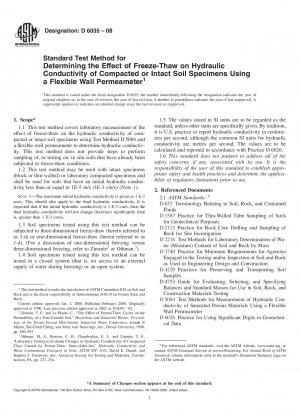ASTM D6035-08
Standard Test Method for Determining the Effect of Freeze-Thaw on Hydraulic Conductivity of Compacted or Intact Soil Specimens Using a Flexible Wall Permeameter
- Standard No.
- ASTM D6035-08
- Release Date
- 2008
- Published By
- American Society for Testing and Materials (ASTM)
- Status
- Replace By
- ASTM D6035/D6035M-13
- Latest
- ASTM D6035/D6035M-19
- Scope
This test method identifies the changes in hydraulic conductivity as a result of freeze-thaw on natural soils only.
It is the user''s responsibility when using this test method to determine the appropriate moisture content of the laboratory-compacted specimens (that is, dry, wet, or at optimum moisture content) (Note 2).
Note 28212;It is common practice to construct clay liners and covers at optimum or greater than optimum moisture content. Specimens compacted dry of optimum moisture content typically do not contain larger pore sizes as a result of freeze-thaw because the effects of freeze-thaw are minimized by the lack of water in the sample. Therefore, the effect of freeze-thaw on the hydraulic conductivity is minimal, or the hydraulic conductivity may increase slightly. ,
The requestor must provide information regarding the effective stresses to be applied during testing, especially for determining the final hydraulic conductivity. Using high effective stresses (that is, 35 kPa (5 psi) as allowed by Test Method D 5084
) can decrease an already increased hydraulic conductivity resulting in lower final hydraulic conductivity values. The long-term effect of freeze-thaw on the hydraulic conductivity of compacted soils is unknown. The increased hydraulic conductivity caused by freeze-thaw may be temporary. For example, the overburden pressure imparted by the waste placed on a soil liner in a landfill after being subjected to freeze-thaw may reduce the size of the cracks and pores that cause the increase in hydraulic conductivity. It is not known if the pressure would overcome the macroscopically increased hydraulic conductivity sufficiently to return the soil to its original hydraulic conductivity (prior to freeze-thaw). For cases such as landfill covers, where the overburden pressure is low, the increase in hydraulic conductivity due to freeze-thaw will likely be permanent. Thus, the requestor must take the application of the test method into account when establishing the effective stress. The specimen shall be frozen to −15°C unless the requestor specifically dictates otherwise. It has been documented in the literature that the initial (that is, 0 to −15°C) freezing condition causes the most significant effects in hydraulic conductivity. Freezing rate and ultimate temperature should mimic the field conditions. It has been shown that superfreezing (that is, freezing the specimen at very cold temperatures and very short time periods) produces erroneous results.
The thawed specimen temperature and thaw rate shall mimic field conditions. Thawing specimens in an oven (that is, overheating) will produce erroneous results.
Literature relating to this subject indicates that the effects of freeze-thaw usually occur by Cycle 10, thus it is recommended that at least 10 freeze-thaw cycles shall be performed to ensure that the full effects of freeze-thaw are measured. If the hydraulic conductivity values are still increasing after 10 freeze-thaw cycles, the test method shall be continued (that is, more freeze-thaw cycles shall be performed).
Note 38212;The quality of the result produced by this standard is dependent on the competence of the personnel performing it, and the suitability of the equipment and facilities used. Agencies that meet the criteria of Practice D 3740
are generally considered capable of competent and objective testing/sampling/inspection/etc. Users of this standard are cautioned that compliance with Practice D 3740 does not in itself assure reliable results. Reliable results depend on many fact............
ASTM D6035-08 Referenced Document
- ASTM D1587 Standard Practice for Thin-Walled Tube Sampling of Soils for Geotechnical Purposes*, 2024-04-20 Update
- ASTM D2113 Standard Practice for Rock Core Drilling and Sampling of Rock for Site Investigation
- ASTM D2216 Standard Test Method for Laboratory Determination of Water (Moisture) Content of Soil and Rock by Mass
- ASTM D3740 Standard Practice for Minimum Requirements for Agencies Engaged in the Testing and/or Inspection of Soil and Rock as Used in Engineering Design and Construction
- ASTM D4220 Standard Practices for Preserving and Transporting Soil Samples
- ASTM D4753 Standard Specification for Evaluating, Selecting, and Specifying Balances and Scales for Use in Soil, Rock, and Construction Materials Testing
- ASTM D5084 Standard Test Methods for Measurement of Hydraulic Conductivity of Saturated Porous Materials Using a Flexible Wall Permeameter*, 2016-08-15 Update
- ASTM D6026 Standard Practice for Using Significant Digits in Geotechnical Data
- ASTM D653 Standard Terminology Relating to Soil, Rock, and Contained Fluids
- ASTM E145 Standard Specification for Gravity-Convection And Forced-Ventilation Ovens
ASTM D6035-08 history
- 2019 ASTM D6035/D6035M-19 Standard Test Methods for Determining the Effect of Freeze-Thaw on Hydraulic Conductivity of Compacted or Intact Soil Specimens Using a Flexible Wall Permeameter
- 2013 ASTM D6035/D6035M-13 Standard Test Method for Determining the Effect of Freeze-Thaw on Hydraulic Conductivity of Compacted or Intact Soil Specimens Using a Flexible Wall Permeameter
- 2008 ASTM D6035-08 Standard Test Method for Determining the Effect of Freeze-Thaw on Hydraulic Conductivity of Compacted or Intact Soil Specimens Using a Flexible Wall Permeameter
- 2002 ASTM D6035-02 Standard Test Method for Determining the Effect of Freeze-Thaw on Hydraulic Conductivity of Compacted or Undisturbed Soil Specimens Using a Flexible Wall Permeameter
- 1996 ASTM D6035-96 Standard Test Method for Determining the Effect of Freeze-Thaw on Hydraulic Conductivity of Compacted or Undisturbed Soil Specimens Using a Flexible Wall Permeameter
